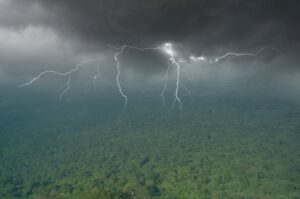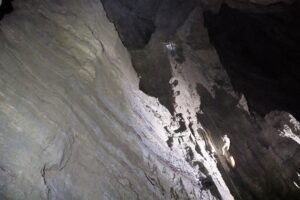Early in its history, long before the dinosaurs, Earth was an unrecognizable, hostile place. Why? There was no air. We could not breathe or exist. But thanks to a little thing called bacteria, we are now able to survive.
According to the U.S. National Park Service, stromatolites were “the dominant life form on Earth for over two billion years and are thought to be primarily responsible for the oxygenation of the atmosphere.”

Stromatolite patterns. Photo: Paulo Afonso
The Age of Bacteria
A couple of billion years ago, the Earth entered what is called the Age of Bacteria. While that sounds slightly odd, this crucial moment in our geological story was responsible for life itself; oxygen. Thanks to these organisms, Earth’s atmosphere increased from an inhabitable 1% oxygen to 20%.
Today, stromatolites show as rare sedimentary rock structures. The term is derived from Greek, meaning “layered rock.” They are created by cyanobacteria, which need sunlight to photosynthesize. As they receive that energy, the cyanobacteria create a sticky substance that binds particles together. This process repeats until it forms multiple layers in a “microbial mat.” Over time, this hardens from precipitating calcium carbonate. They are considerably softer than most rocks.

Stromatolites at Port Epworth, in Canada’s Northwest Territories. Photo: Jerry Kobalenko
The oldest life on Earth
Stromatolites are colonial organisms and are the oldest life on our planet. They still, surprisingly, exist today. In the 1970s, individuals found stromatolites in a closed asbestos mine. This showed that stromatolites not only occur naturally but also through human activities.
They take various shapes, from columns to stumps and cones. Often they resemble gigantic cauliflowers or cinnamon buns. Some species are spongy while have a smoother surface. If you cut one open, they show endless layers in zigzags and wave-like patterns. The changing axes are due in part to the changing seasons, as the bacteria orient to the sun.
They can grow up to two meters high but at an agonizingly slow rate of 0.4mm annually. It takes thousands of years for a colony to gradually calcify into rock.
These living fossils take on a brownish-grey color but also usually have a green or blue hue due to algae on their surface. You find them in aquatic settings in both salt and freshwater. Because cyanobacteria can survive in harsh conditions, stromatolites can thrive in hyper-saline environments.
They are related to thrombolites, which are also colonies of microorganisms. Stromatolites and thrombolites grow by a similar process, but thrombolites have random patterns rather than layers. Both thrive in Western Australia, Argentina, Mexico, Turkey, and Canada.
Once existed on Mars?
Stromatolites tell us a great deal about Earth’s history but could also possibly indicate life on other planets. Scientists suggest they might have once existed on Mars. They believe that Mars could have had an early beginning like Earth, with a carbon dioxide-rich atmosphere.
As with most phenomena in the natural world, they are under threat. People walk on them, vandalize them, and touch them too much. This can lead to premature erosion and disintegration. Stromatolite reefs in Australia have already reported an increase in phosphorus in the water, which can kill their growth. To preserve these ancient fossils, look but do not touch.






